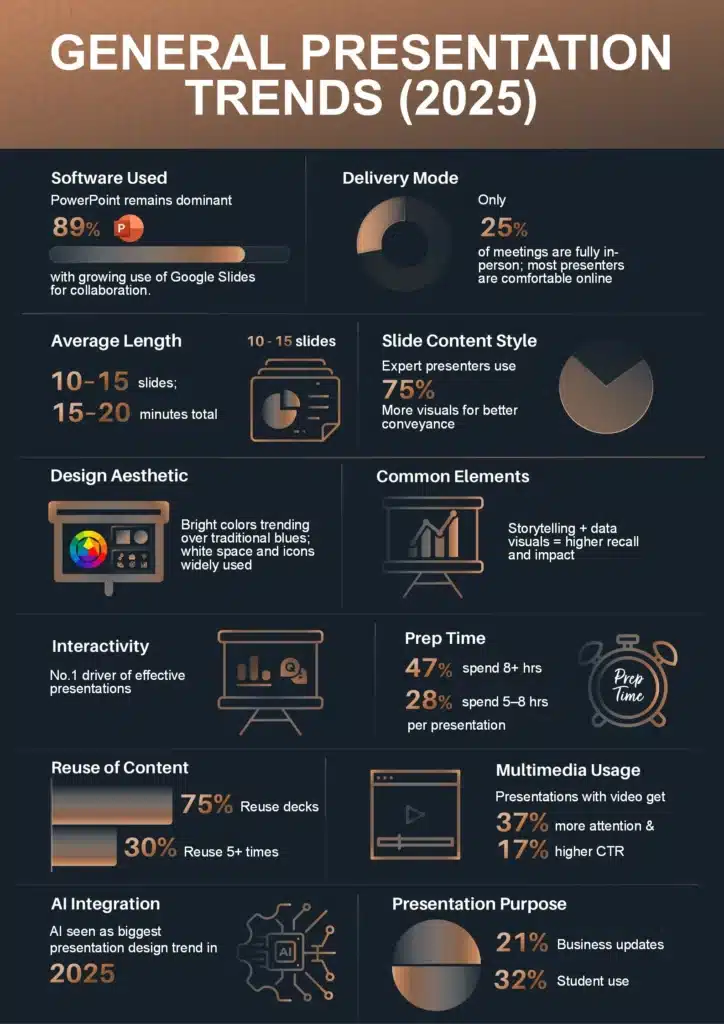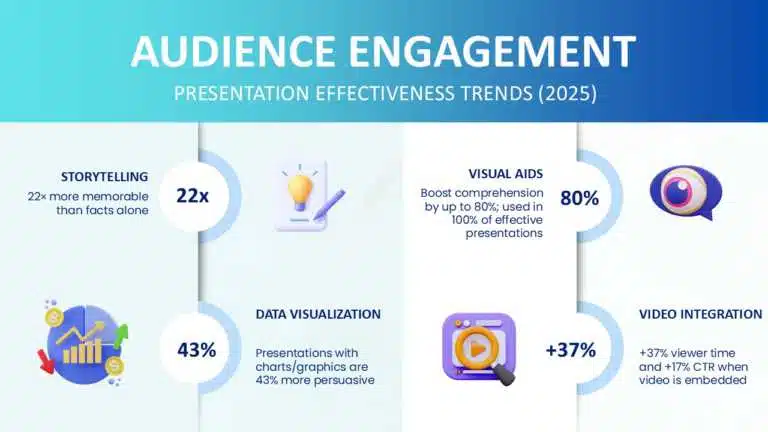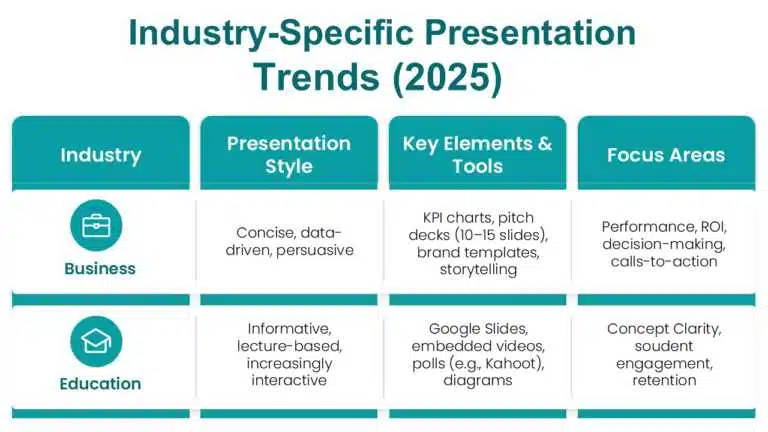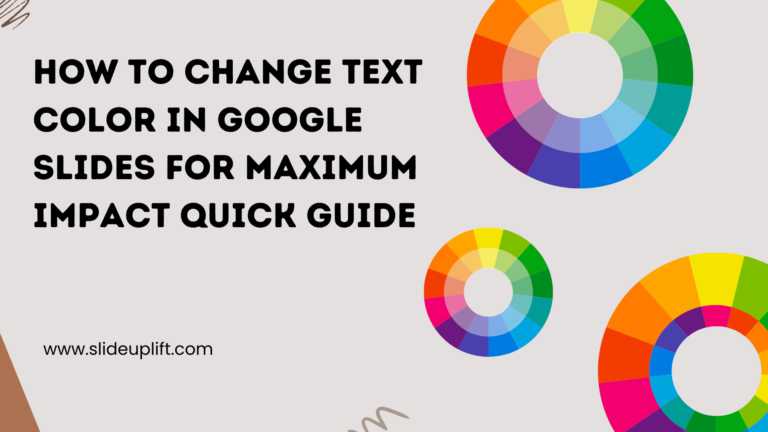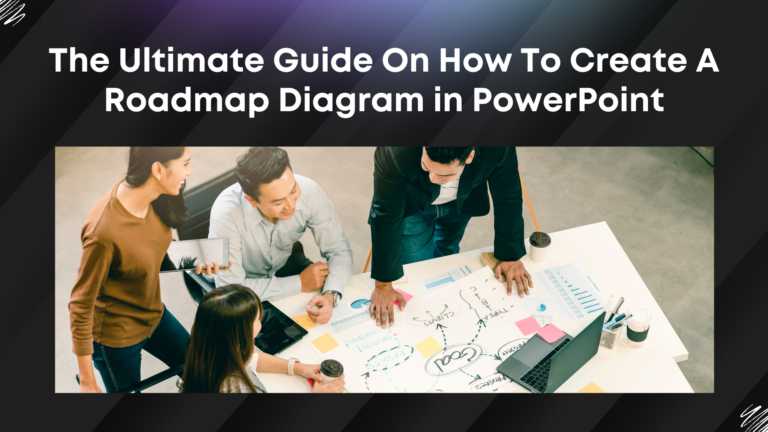Presentation Statistics: What You Need to Know for Your Next Presentation
In 2025, presentations have evolved far beyond static slide decks and long monologues. Modern presentations are dynamic, interactive, and data-driven, designed to captivate audiences, enhance understanding, and inspire action. Whether in boardrooms, classrooms, or online meetings, effective presentation strategies are critical for success. This blog explores the latest presentation trends, key audience engagement tactics, and industry-specific shifts, supported by data-driven insights and visual summaries.
These key presentation statistics and trends provide the foundation for understanding what makes a presentation truly effective in today’s fast-paced, visual world.
The Need for Concise Presentations: Navigating Attention Span Constraint
Presentations should not be more than 20 minutes
- Most audiences prefer presentations lasting between 10 to 15 minutes, as this timeframe effectively delivers key points without overwhelming the audience. Shorter presentations (under 10 minutes) help boost attention, emphasize visuals, and improve delivery, but they may miss important details. On the other hand, longer presentations risk losing audience interest. Finding the perfect balance between short and long presentations ensures clarity, retention, and meaningful engagement, leaving a lasting impact without underdelivering or overwhelming the audience.
Attention spans are dropping, expected to reach just eight seconds by 2025
- To capture and maintain interest, presentations should be concise—ideally 10 to 15 minutes—focusing on clear key points and strong visuals. This balance boosts engagement, enhances retention, and leaves a lasting impact.
The optimal presentation length for an audience member is about 10 slides
- Keeping presentations to around 10 slides helps maintain interest and clarity. Each slide should serve a purpose, focusing on key points without clutter.
About a fifth of the participants said they looked at another screen constantly during presentations
- Roughly 20% of people report being distracted by other screens during presentations. This underscores the need for lively, interactive delivery and effective use of visuals. Reducing clutter and increasing engagement helps presenters hold attention and deliver memorable messages.
Why Every Great Presentation Needs to Start with Powerful Imagery.
100% of people think a slide should include visuals
- Visuals are essential for effective presentations. Graphics, images, and videos grab attention and improve recall. They support key points and enhance storytelling, making slide decks more impactful. As visual data use grows, strong graphics are key to presentation success.
People prefer about one-fourth of the slide to be composed of text at most
- Audiences respond best to minimal text—ideally, no more than one-fourth of the slide. This allows visuals like charts and images to stand out, making content easier to understand and remember.
People remember just 10% of what they hear, but up to 65% when visuals are added
- Using infographics, photos, and videos increases engagement and helps key messages stick.
Boost Attention with 60% Animation, 45% Transitions
- Animations and transitions boost viewer focus when used well. Around 60% of presenters use animations to clarify ideas, and 45% use transitions to maintain interest and to make PowerPoint presentations attractive. These tools make presentations more dynamic and memorable.
How Professionals Spend A Lot Of Time Building Presentations
Most people create at least one presentation per week
- Many professionals make at least one presentation weekly, showing the importance of strong communication in business. Frequent presenting helps improve skills, boost audience connection, and build confidence. With the right tools and clear messaging, presenters can leave a lasting impression and tackle challenges creatively.
It takes most people at least a few hours to assemble a 10-slide presentation
- Preparing a 10-slide presentation often takes several hours. This time goes into crafting strong visuals, refining messages, and ensuring clarity. A well-prepared presentation not only eases delivery but also reduces anxiety and increases impact, especially during public speaking.
Almost 75% of people reuse the same slide deck at least once
- Nearly three-quarters of professionals reuse slide decks, and half rely on templates to avoid starting from scratch. This approach saves time, reduces stress, ensures consistent messaging, and lets presenters focus on impactful delivery and storytelling.
Benefits of rehearsing presentations
- Rehearsing your presentation helps improve delivery, reduce anxiety, and refine key points for clarity. The more you practice, the more confident and polished you become, ensuring a stronger connection with your audience. Strong presentation Skills lead to better retention, a more impactful performance, and a greater chance of success.
How Presenters Are Becoming Facilitators Of Engaging Experiences.
Stories are 22 times more memorable than standalone facts
- Storytelling transforms presentations by turning complex data into relatable, memorable narratives that create an emotional connection with the audience. When paired with structured slides and visuals, it becomes even more powerful, boosting understanding and recall. This combination keeps audiences engaged, enhances retention, and ensures key messages stick long after the presentation ends.
Presentation with Interactive Elements Are Read 41% and More 21% Longer
- Interactive tools like live polls, Q&A sessions, and real-time feedback turn passive listeners into active participants. This boosts engagement, improves retention, and builds a stronger presenter-audience connection. Follow-up materials, such as slide decks or summaries, reinforce key points and help keep the message top of mind even after the presentation ends.
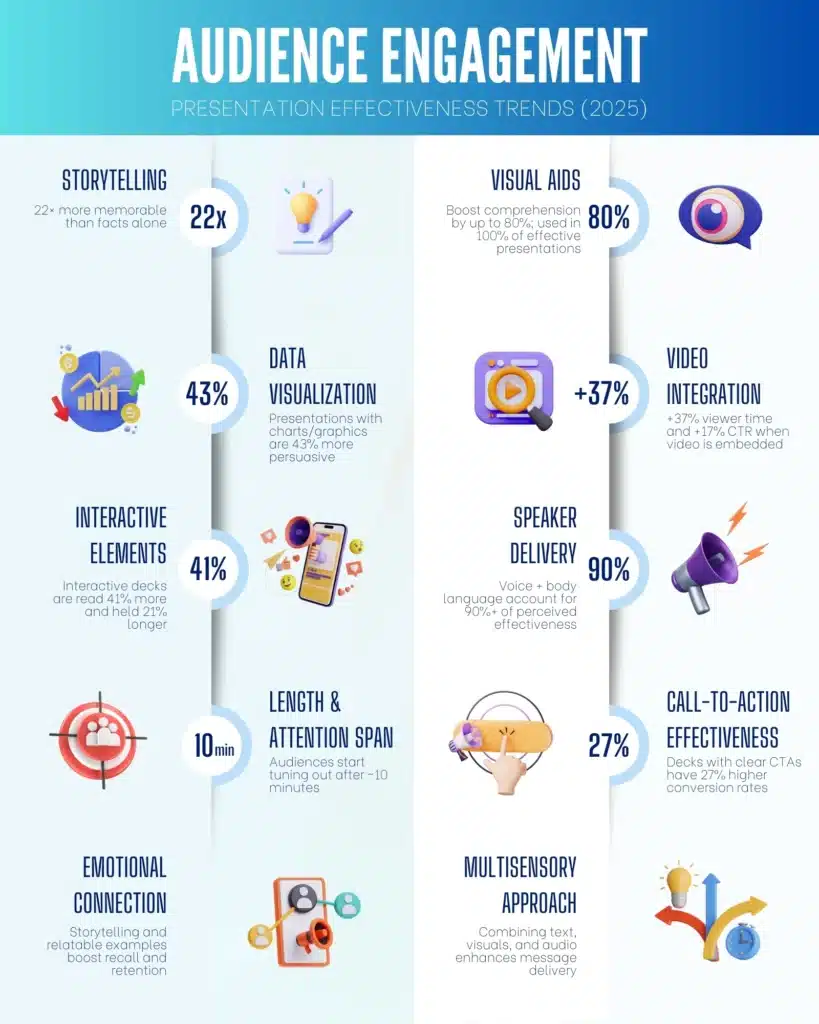
General Presentation Trends in 2025
89% Of Users still use PowerPoint
- The presentation software market is shifting fast. Alternatives like Google Slides and Prezi are becoming popular as professionals look for tools that offer better visuals and interactive features. This reflects a growing need for platforms that support engaging storytelling and more memorable delivery.
Mobile is on the rise: 32% of decks are opened on mobile
- With more presentations being viewed on mobile devices, presenters must adapt their designs. Clean layouts, larger visuals, and minimal text help maintain clarity and boost engagement across all screen sizes. Roughly a third of professionals now present from mobile devices. This shift emphasizes the need for mobile-optimized content and flexible design that keeps the audience engaged on the go.
71% of businesses have adopted generative AI in at least one function, in presentations
- Artificial Intelligence is transforming presentations by automating content creation, layout suggestions, and real-time edits, streamlining prep time and enhancing design quality. With over 700 million users projected by 2030 and the market set to reach $5 billion by 2031, AI tools are becoming essential for crafting polished, personalized, and high-impact presentations.
60% of Presenters Face Tech Glitches
- About 60% of presenters face technical issues like faulty projectors or software problems. These disrupt engagement and retention. Testing tools in advance ensures smoother delivery and better audience interaction.
Industry-Specific Presentation Trends in 2025.
Presentation needs are not one-size-fits-all. Different industries have unique requirements when it comes to communicating with their audience. However, a common thread among all sectors is the increasing use of visuals, storytelling, and digital tools to enhance the impact of presentations.
- Business: Presentations are typically data-driven, concise, and persuasive. They focus on key performance indicators (KPIs), growth strategies, and return on investment (ROI). The goal is to deliver straightforward information that aids in decision-making and demonstrates clear outcomes.
- Education: Presentations are designed to be both informative and interactive. Educators often incorporate videos, polls, and quizzes to boost student engagement and make the material more dynamic. This approach encourages active participation, helping students grasp complex concepts in a more engaging and memorable way.
- Healthcare: Presentations rely heavily on evidence-based content. Healthcare professionals often use clear visuals, such as charts, graphs, and patient outcome data, to communicate complex research findings and clinical results. The aim is to simplify intricate medical information for both colleagues and patients.
- Technology: Presentations are demo-heavy and sleek, with a focus on product showcases, system architecture diagrams, and technical specifications. The goal is to demonstrate the functionality of new innovations and their potential impact on the market or industry.
- Sales and Marketing: Storytelling plays a crucial role, with presentations designed to be high-impact, combining visuals with a narrative that highlights pain points and solutions. This approach makes the message persuasive and memorable, encouraging prospects to take action.
By aligning presentation styles with the specific needs and expectations of each industry, presenters can maximize engagement and effectively communicate their messages, ultimately leading to more successful outcomes.
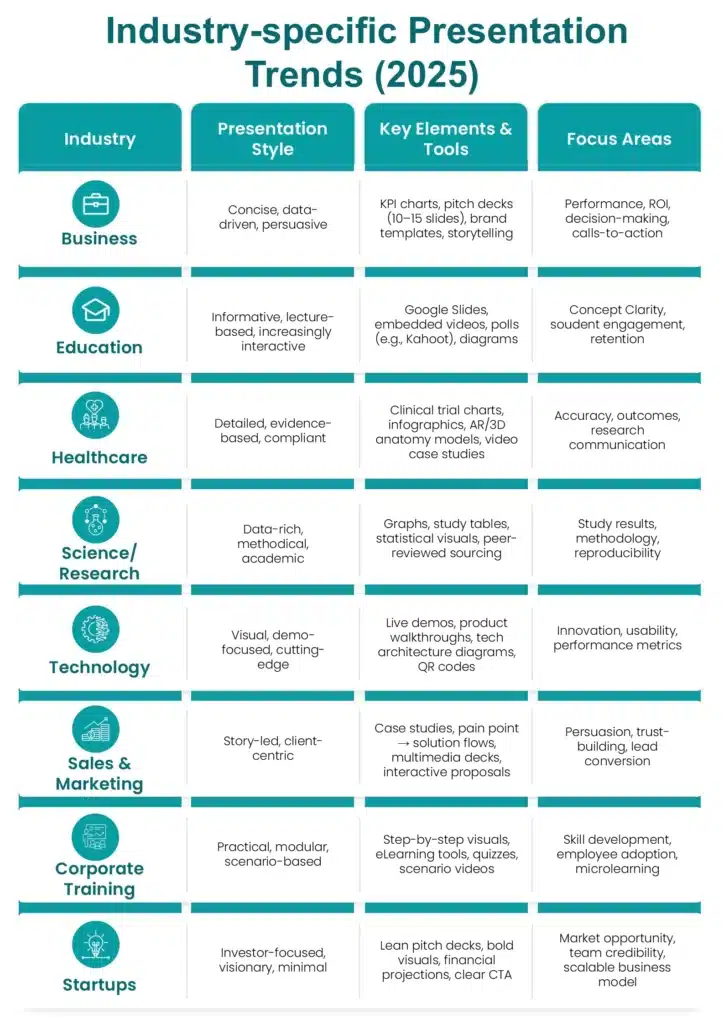
Conclusion
Delivering a successful presentation requires more than just great content—it’s about engaging your audience with the right techniques and tools. Key insights, such as optimal presentation length, the power of visuals, and concise delivery, are essential for making an impact. Storytelling, AI tools, and mobile-friendly design are also crucial in today’s fast-paced world. Understanding these trends and tailoring your presentation to your audience’s needs ensures clarity, engagement, and lasting impact. Master these strategies, and your presentations will be more memorable and effective every time.
FAQs
-
How do you get your audience to sit up in their seats and focus?
Using engaging visuals, interactive elements, and storytelling can really grab your audience’s attention. Changing your way of delivering the content and the pace can also keep listeners interested. Knowing what they like will help them focus better, making the presentation more memorable.
-
How do you keep your audience engaged?
To keep your audience interested, you should use storytelling and visuals well. You can also add interactive elements like polls or Q&A sessions. Keeping a steady pace and encouraging people to join in can greatly improve retention and make the presentation more enjoyable.
-
How much can you grasp in 15 seconds?
In 15 seconds, people can only take in a small amount of information. This short time shows how important it is to use clear messages and engaging images to help with understanding and retention during presentations. It’s key to grab attention in this quick moment.
-
How do I ensure the accuracy and credibility of the statistics I present?
To make sure your statistics are accurate and trustworthy, use reliable sources. Check your data with different references and look for recent publications. Peer-reviewed studies and industry reports can boost your credibility. This way, you help keep the audience’s trust in what you present.
-
Is it better to use graphs or words for a presentation?
Using graphs in presentations can help people understand and remember information better. Visuals make complex data easier to grasp. However, words are also important for giving context and details. The best way is to mix both graphs and words to keep things clear while keeping the audience engaged.
-
Generally, how long should a presentation be?
A good presentation should be about 10 to 15 minutes long. This length helps keep audience members engaged. It’s also the usual attention span for most people, so you can share your key messages clearly.

